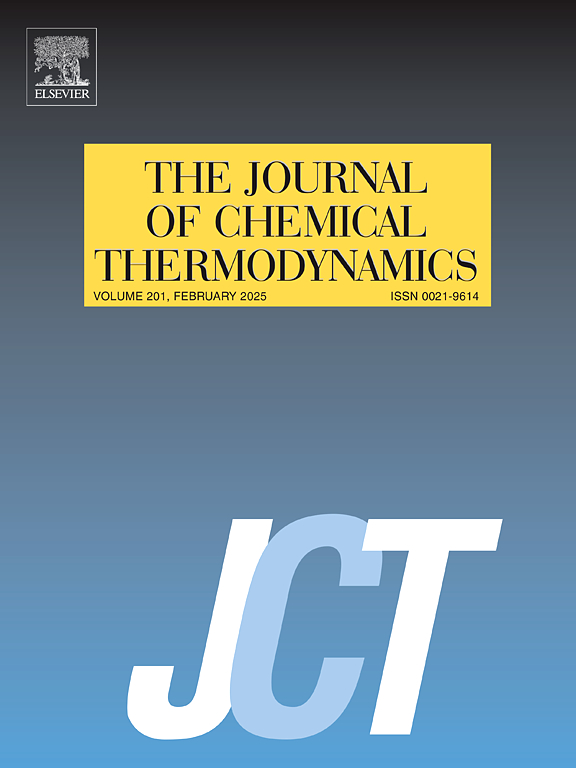2,3,4-三甲氧基苯甲酸在278.15 K - 318.15 K 12种溶剂中的溶解度测量和热力学建模
IF 2.2
3区 工程技术
Q3 CHEMISTRY, PHYSICAL
引用次数: 0
摘要
2,3,4-三甲氧基苯甲酸(TMBA)在不同溶剂中固液平衡的热力学参数对其在制药工程和工业应用中的初步研究具有重要意义。采用质谱仪对TMBA在水、乙二醇、异丙醇、正丙醇、乙酸正丙酯、乙酸异丙酯、乙酸正丁酯、乙醇、乙酸乙酯、2-丁氧基乙醇、2-甲氧基乙醇、乙二醇乙醚等12种纯溶剂中,在温度为278.15 ~ 318.15 K、0.1 MPa条件下的固液平衡进行了校正。温度范围的研究表明,TMBA在溶剂中的溶解度随温度的升高而升高。TMBA在乙二醇乙醚中的溶解度优于其他选定的纯溶剂。采用Van't Hoff模型、修正Apelblat模型、Buchowski-Ksiazaczak λh模型和多项式经验模型来描述和预测溶解度的变化趋势。计算结果表明,范霍夫模型更为合适,具有较高的适用性。通过cat - lser模型研究了溶剂对TMBA溶解度的影响,证实了氢键给予(α)和温度(1/T)主导了TMBA的溶解度,而氢键接受(β)则受到抑制。计算得到的热力学参数分别为ΔsolG°(3.0994-17.8991 kJ mol−1)、ΔsolH°(15.6814-28.5220 kJ mol−1)和ΔsolS°(35.6965-101.0757 J mol−1 K−1),表明TMBA在各溶剂中的溶解均为吸热、熵增和熵驱动过程。本文章由计算机程序翻译,如有差异,请以英文原文为准。
Solubility measurement and thermodynamic modeling of 2,3,4-trimethoxybenzoic acid in 12 solvents across a temperature range of 278.15 K–318.15 K
The thermodynamic parameters on corresponding solid-liquid equilibrium of 2,3,4-Trimethoxybenzoic acid (TMBA) in different solvents are essential for a preliminary study of pharmaceutical engineering and industrial applications. A mass method was used to correct the solid-liquid equilibrium of TMBA in 12 pure solvents (Water, Ethylene glycol, Isopropanol, n-Propanol, n-propyl acetate, Isopropyl acetate, n-Butyl acetate, Ethanol, Ethyl acetate, 2-Butoxy ethanol, 2-Methoxyethanol, Ethylene glycol ethyl ether) in the temperatures (from 278.15 to 318.15 K) under 0.1 MPa. For the temperature range investigation, the solubility of TMBA in the solvents increased with increasing temperature. The solubility of TMBA in Ethylene glycol ethyl ether is superior to other selected pure solvents. The Van't Hoff model, modified Apelblat model, Buchowski-Ksiazaczak λh model and Polynomial empirical model were adopted to describe and predict the change tendency of solubility. Computational results showed that the Van't Hoff model stood out to be more suitable with the higher applicability. And, the solvent effects on TMBA solubility were studied by the KAT-LSER model, which confirms that hydrogen bond donation (α) and temperature (1/T) dominate TMBA's solubility, while hydrogen bond acceptance (β) exhibits inhibition. In addition, the calculated thermodynamic parameters include ΔsolG° (3.0994–17.8991 kJ mol−1), ΔsolH° (15.6814–28.5220 kJ mol−1), and ΔsolS° (35.6965–101.0757 J mol−1 K−1), which indicated that in each studied solvents the dissolution of TMBA is endothermic, entropy increasing and entropy-drive process.
求助全文
通过发布文献求助,成功后即可免费获取论文全文。
去求助
来源期刊

Journal of Chemical Thermodynamics
工程技术-热力学
CiteScore
5.60
自引率
15.40%
发文量
199
审稿时长
79 days
期刊介绍:
The Journal of Chemical Thermodynamics exists primarily for dissemination of significant new knowledge in experimental equilibrium thermodynamics and transport properties of chemical systems. The defining attributes of The Journal are the quality and relevance of the papers published.
The Journal publishes work relating to gases, liquids, solids, polymers, mixtures, solutions and interfaces. Studies on systems with variability, such as biological or bio-based materials, gas hydrates, among others, will also be considered provided these are well characterized and reproducible where possible. Experimental methods should be described in sufficient detail to allow critical assessment of the accuracy claimed.
Authors are encouraged to provide physical or chemical interpretations of the results. Articles can contain modelling sections providing representations of data or molecular insights into the properties or transformations studied. Theoretical papers on chemical thermodynamics using molecular theory or modelling are also considered.
The Journal welcomes review articles in the field of chemical thermodynamics but prospective authors should first consult one of the Editors concerning the suitability of the proposed review.
Contributions of a routine nature or reporting on uncharacterised materials are not accepted.
 求助内容:
求助内容: 应助结果提醒方式:
应助结果提醒方式:


